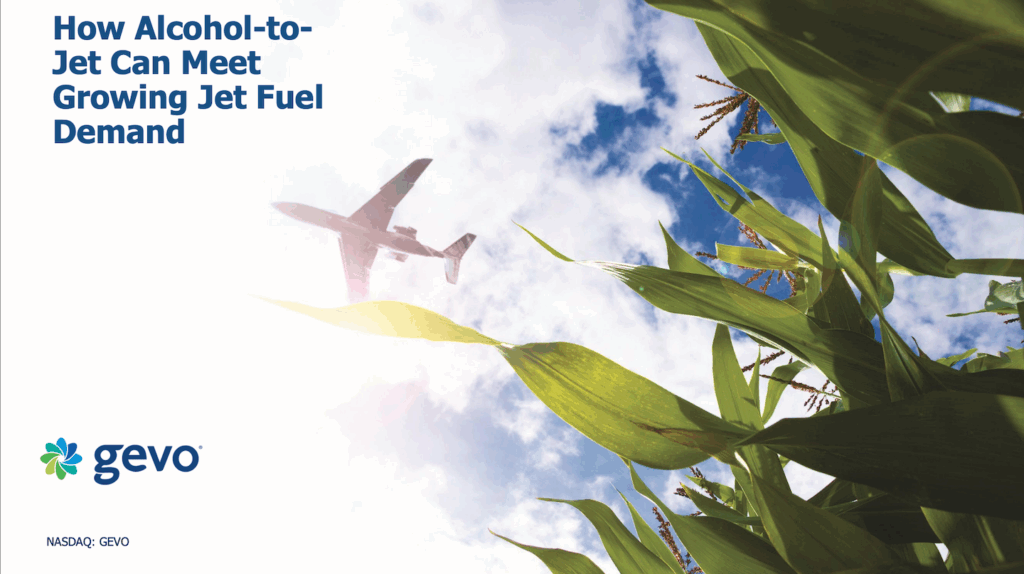Gevo has long explored various processes, including synthetic biology and industrial chemistry, to develop cost-competitive pathways to create SAF (synthetic aviation fuel) using alcohol-to-jet (ATJ) and ethanol-to-jet (ETJ) methods and exploring the benefits of bio-based feedstocks.
Depending on the feedstocks used and the efficiencies built into the production process, our SAF is a renewble jet fuel that offers enough carbon abatement and sustainability as attributes that it can be classified as sustainable aviation fuel (SAF).

Since it is ready to replace petroleum-based jet fuel, our ATJ SAF is demonstrated to meet or exceed the standards in ASTM D1655/7566 specification, which specifies blending up to 50 percent (though we’ve flown test aircraft on 100-percent SAF). Here’s a breakdown:
- For flash point, the standard stipulates a 38 degrees C minimum, and ATJ is well within acceptable range at 45 to 50 degrees C.
- Both also pass the standard for thermal oxidation stability.
- For freezing point, the standard requires -40 degrees C maximum for Jet A and -47 degrees C for Jet A-1, and Jet A-1 complies with -50 degrees C, while ATJ is -78 degrees C.
- The energy density standard is 42.8 MJ/kg minimum, and Jet A-1 complies with 42.9 MJ/kg, while ATJ has 44.0 MJ/kg.
- The total sulfur content standard is 0.3 percent max, while Jet A-1 comes in at 0.05 percent and ATJ rates at less than 0.00 percent.

SAF Opportunities
While the terms Synthetic Aviation Fuel (SAF) and Sustainable Aviation Fuel (SAF) are often used interchangeably, there are important distinctions. Here’s a helpful breakdown of the determining qualifications for each label:
Synthetic Aviation Fuel
Synthetic aviation fuel refers to hydrocarbons created through chemical synthesis. These fuels can be derived from a wide range of sources, not all of which are sustainable, and have the following characteristics:
- Usually considered sustainable aviation fuel only if the production process meets sustainability criteria.
- Source materials also are a factor in determining the level of sustainability—not considered inherently sustainable unless made from green H₂ and captured CO₂.
- Often made from fossil sources, such as coal or natural gas
- Examples include:
PtL (Power-to-Liquid) using electricity to produce hydrogen via electrolysis and then combine it with carbon dioxide (CO2) to synthesize various liquid hydrocarbons fuels.
CTL (Coal-to-Liquid) using coal
GTL (Gas-to-Liquid) using natural gas
Sustainable Aviation Fuel
SAF is an umbrella term for aviation fuels that reduce lifecycle greenhouse gas (GHG) emissions compared to conventional jet fuel. They must meet sustainability criteria, including feedstock origin and carbon intensity over the lifecycle of the product, and have the following characteristics:
- Derived from renewable or waste-based feedstocks.
- Must reduce lifecycle CO₂ emissions by at least 50 percent (per ICAO CORSIA standards).
- Examples include:
HEFA-SPK (Hydroprocessed Esters and Fatty Acids Synthetic Paraffinic Kerosene) from used cooking oil or animal fats
FT-SPK (Fischer Tropsch Synthetic Paraffinic Kerosene) produced through a process called Fischer-Tropsch synthesis, which converts synthesis gas, a mixture of carbon monoxide and hydrogen, into liquid hydrocarbons from solid waste or biomass
ATJ (Alcohol-to-Jet) converts alcohols like ethanol and butanol, derived from renewable sources, into sustainable aviation fuel
PtL (Power-to-Liquid) use renewable electricity to produce hydrogen via electrolysis and then combine it with carbon dioxide (CO2) to synthesize various liquid hydrocarbons fuels.
Read About How Gevo Expects to Meet Growing Jet Fuel Demand with SAF
Summary of SAF-Type Differences:
Here’s a chart summarizing the key differences between Synthetic Aviation Fuel and Sustainable Aviation Fuel, followed by real-world examples of companies and technologies in each category.
| Feature | Synthetic Aviation Fuel | Sustainable Aviation Fuel |
|---|---|---|
| Definition | Fuel created via chemical synthesis | Fuel made from renewable or waste-based sources with lower lifecycle CO₂ |
| Scope | Narrow (focuses on fuels made via synthesis) | Broad (includes all sustainable fuels) |
| Sustainability Required? | Not necessarily (may use fossil sources) | Yes (must meet strict sustainability standards) |
| Common Feedstocks | CO₂ + green H₂ (sustainable) or coal/gas (non-sustainable) | Used cooking oil, agricultural waste, municipal solid waste, CO₂ + H₂ |
| Lifecycle GHG Reduction | Can vary from -100% to worse than fossil, depending on inputs | ≥ 50% reduction vs fossil jet fuel (typically) |
| Examples of Fuel Types | PtL, CTL (not sustainable), GTL | HEFA, FT-SPK, ATJ, PtL (if sustainable) |
| Certified for Aviation? | Only certified if feedstock and process meet criteria | Some are certified (ASTM D7566 pathways) |
| Included in Sustainability Programs? | Only if sustainable (e.g. e-jet fuel from green H₂ + captured CO₂) | Yes, if meets sustainability and certification |
Real-World Examples of SAF Producers—Synthetic and Sustainable
Companies and technologies in each category.
Synthetic Aviation Fuel Producers
| Company | Fuel Type | Feedstock | Sustainable Compliant? |
| Sasol | GTL (Gas-to-Liquid) | Natural Gas | Not Sustainable |
| Shell (historical) | CTL (Coal-to-Liquid) | Coal | High Emissions |
| HIF Global | PtL (e-jet fuel) | CO₂ + renewable electricity | If Fully Renewable |
| Prometheus Fuels | PtL (electrofuel) | Direct air capture + green H₂ | If Powered by Renewables |
Sustainable Aviation Fuel Producers
| Company | Fuel Type | Feedstock | Notes |
| Neste | HEFA-SPK | Used cooking oil, animal fats | One of the largest commercial SAF producers |
| World Energy | HEFA-SPK | Waste fats & oils | SAF supplier for major airlines |
| Velocys | FT-SPK | Municipal solid waste | Uses Fischer-Tropsch process |
| LanzaJet | ATJ | Ethanol from waste biomass | Commercial ATJ pathway |
| Sunfire | PtL (synthetic SAF) | CO₂ + green hydrogen | Electrofuels, based in Germany |
How Does Gevo Fit in the World of SAF?
Gevo Inc. is a U.S.-based company that produces Sustainable Aviation Fuel (SAF), and they fall into the “Alcohol-to-Jet” (ATJ) category, developing both ATJ and Ethanol-to-Jet (ETJ) pathways.
Gevo SAF at a Glance
| Feature | Details |
| Fuel Type | Alcohol-to-Jet (ATJ-SPK) SAF |
| Feedstock | Industrial corn (non-food grade) → isobutanol (an alcohol) |
| Process | Fermentation of carbohydrates → isobutanol → hydroprocessed into jet fuel |
| SAF Certification | ASTM D7566 Annex 5 (ATJ-SPK certified up to 50% blend) |
| Lifecycle GHG Reduction | Up to 70–90% vs fossil jet fuel, depending on feedstock and energy inputs |
| Sustainability Strategy | Uses renewable electricity, integrates carbon capture, and tracks carbon intensity via Distributed Ledger Technology using blockchain |
| Facilities | Developing the ATJ60 facility in Lake Preston, South Dakota Gevo North Dakota ethanol-production facility with carbon capture and sequestration facility |
Learn More About How Gevo’s Alcohol-to-Jet SAF Pathway Can Help Meet Growing Jet Fuel Demand

Click this link to be directed to the presentation on Gevo’s Investor site.
Why Gevo’s SAF Is Both Synthetic and Sustainable

- Gevo’s process synthesizes jet fuel molecules, but from biologically derived alcohols.
- Since the source is renewable (plant-based sugars from regeneratively grown corn) and the process is engineered to minimize emissions, Gevo’s fuel meets sustainability criteria.
- Therefore, while it’s chemically synthesized, it is certifiable as sustainable aviation fuel under the ATJ-SPK pathway.
Gevo in the SAF Ecosystem
| Type | Gevo’s Role? | Notes |
| Bio-based SAF | Yes | From corn sugars (fermentation) |
| Synthetic SAF | Partially | Uses chemical synthesis, but from renewable feedstock |
| Fossil-based synfuels | No | Gevo does not use fossil inputs |
| Power-to-Liquid | No (not currently) | Doesn’t use CO₂ + green H₂ route, though is exploring green hydrogen as a product |
Strategic Positioning
Gevo is a “carbon-aware fuels company” integrating:
- Cost-competitive fuels that deliver renewable energy and are derived from bio-based feedstocks
- Carbon abatement using carbon capture and sequestration to reduce carbon intensity and offer added value through the sale of high-quality carbon credits
- Life-cycle carbon tracking using distributed ledger technology based on blockchain
- Renewable energy
- Regenerative agriculture, partnering with farmers to lower input emissions, and improve yield and enhancing soil health
